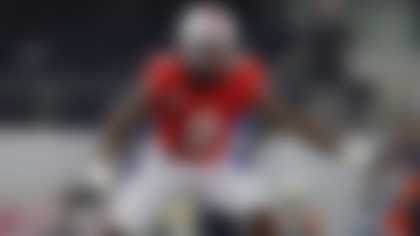The next great NFL quarterback might be drafted early. He might be drafted in the third round. He might even be drafted on Day 3. But there is one place teams should avoid when looking for the star signal caller of tomorrow: late in Round 1.
The notion that a franchise passer can be had at a slight discount is an attractive one. Who wouldn't like to land an elite talent at a less-than-elite price (that is, with the 12th overall pick or later)? But analysis of data over the past 25 years suggests late first-round picks are better spent on positions other than QB.
Yes, the Los Angeles Rams paid a lot in their trade for the No. 1 overall pick in the 2016 NFL Draft. But if they're looking for a quarterback, they did exactly what the numbers suggest they should have done in moving up 14 spots. That is, they got out of the QB dead zone and put themselves in position to grab one of the top-rated players available.
The numbers behind the story
When analyzing the relationship between quarterback performance and draft position, it is important to account for the fact that QBs have been picked more frequently in certain stages of the NFL draft. For example, while many premier QBs were originally drafted early in the first round (e.g., Super Bowl 50's Peyton Manning, who was the first overall pick in 1998, and Cam Newton, the first overall pick in 2011), it is also true that more QBs are selected in that part of the draft than in most other stages. Thus, one could argue that, simply based on overall volume, it is not surprising many early first-rounders are among the league's more successful quarterbacks.
So let's look at another method for comparing the performance of quarterbacks selected at different stages in the draft, while adjusting for differences in prevalence among the entire population: the "lift" for each stage. For this analysis, we will use the term "s-lift" (stage lift) to represent the value of different stages in the draft. High s-lift for a given stage suggests high-quality QBs are common in that stage, while low s-lift for a given stage reflects the relative scarcity of high-quality QBs in that stage.
In order to compute s-lift, we first need to establish the baseline population and examine the breakdown of QBs by different draft stages. Between 1990 and 2015, 294 QBs were drafted in the NFL in Rounds 1 through 7. Many QBs were drafted early in the first round (41, or 13.9 percent); in subsequent stages, the totals ranged from 21 (7.1 percent) to 50 (17.0 percent).
Let's define top performers as those in approximately the top 20 percent (in this case, the top 60), and let's consider a few key statistical categories: total passing touchdowns, total passing yards, winning percentage, yards per attempt and passer rating. It is reasonable to assume that a quarterback who performs well in these categories is likely to help his team contend. This mix of categories includes stats that reflect long-term success (career passing yards and touchdowns) and those that can be computed for players with limited experience (winning percentage, yards per attempt, passer rating). Note: When analyzing winning percentage, yards per attempt and passer rating, we excluded quarterbacks who have played fewer than five NFL games, to avoid anomalies like Ryan Nassib (who has a career passer rating of 152.1 -- and just 10 career pass attempts). Also, in cases where there was a statistical tie, the top 61 quarterbacks were considered.
Unsurprisingly, early first-rounders -- college stars who play above their peer group and often go on to shine as pros -- have the highest s-lift across all of the metrics. That's not to say picking a quarterback early locks a team into the playoffs, of course; consider the infamous examples of Ryan Leaf (the second overall pick in 1998 had a 4-17 record over four NFL seasons) and JaMarcus Russell (the first overall pick in 2007 went 7-18 over three NFL seasons).
More notably, though, the s-lift for late first-rounders (again, those picked 12th or later) is less than the s-lift of second-rounders in all of these metrics, sometimes by a large amount. This highlights the historical underperformance of QBs drafted in this range.
Consider that, if the chances of selecting a franchise QB steadily decrease with pick number -- a reasonable presumption, as the talent level should decrease as the draft goes on -- the s-lift should also steadily decrease. And, indeed, this is roughly the trend after Round 2 (and for running backs and wide receivers discussed below). However, in four of the five categories, the late first-round QBs rank between the second- and third-rounders -- and in passer rating, the late first-rounders rank below the third-rounders!
But what's the worst that could happen?
A brief look at some of the quarterbacks picked in the late first round illustrates the grim scenario potentially awaiting teams willing to take the risk. Think of the Browns' recent history of late first-round failure, represented by Brady Quinn (No. 22 overall in 2007), Brandon Weeden (No. 22 overall in 2012) and Johnny Manziel (No. 22 overall in 2014) -- so many misfires that it's fair to wonder if Cleveland's knack for failing to develop those quarterbacks has skewed the data.
Of course, there have been other quarterbacks just good enough to be selected in the first round but not good enough for long-term success in the NFL, including Cade McNown (picked 12th overall by the Bears in 1999), J.P. Losman (picked 22nd overall by the Bills in 2004), Todd Marinovich (picked 24th overall by the Raiders in 1991) and Tim Tebow (picked 25th overall by the Broncos in 2010). So it's not just the Browns.
Why the late first-round QB blues?
While there does seem to be a consistent pattern of s-lift for several QB metrics, it would be foolhardy to conclude that draft-pick number alone determines future success, since there are so many other factors involved. After all, if Peyton Manning had been drafted 26th overall in 1998 instead of first, would his career have been more like that of 1997's 26th overall pick, Jim Druckenmiller (1-0 record in two NFL seasons, with a career passer rating of 29.2)? We know better than that, given the talent, persistence, leadership and meticulous preparation Manning displayed throughout his Hall of Fame-caliber tenure -- while playing for two different organizations, no less.
So s-lift values are less helpful when trying to determine what exactly has caused late first-round QBs to underperform. But considering NFL dynamics and how young players adjust to increased competition might provide some insight.
Players selected in the first round face pressure to perform immediately, thanks in part to their relatively high rookie salaries. Between the demand for good quarterback talent and the difficulty of projecting pro performance, a preponderance of "second-tier" players could be landing in situations that require more of them than they are immediately prepared to handle. Simply put, for the most part, truly elite quarterback prospects are going to be drafted by the time the 12th overall pick rolls around, meaning teams are reaching on anyone selected between that point and the end of Round 1.
There are exceptions, of course. Aaron Rodgers (picked 24th overall by the Packers in 2005) spent the first three years of his career on the bench behind Brett Favre -- and he was seen by many as an elite talent heading into the draft, with differences in teams' needs likely contributing to his fall. Joe Flacco (picked 18th overall by the Ravens in 2008) came from relative obscurity as a Delaware product, which might have reduced the spotlight on him as he developed. Chad Pennington (picked 18th overall by the Jets in 2000) similarly came from a relatively small school (Marshall) and served an apprenticeship under Vinny Testaverde similar to Rodgers' time behind Favre. And there's Teddy Bridgewater, the 32nd overall pick in 2014, who helped Minnesota to the playoffs last season.
The bottom line is, from a historical standpoint, teams with a late first-round pick in need of a QB may want to consider filling other gaps in personnel and searching for a signal caller in later rounds, where the realized value is better aligned with the value of the pick.
How does this apply to the 2016 NFL Draft?
First, it indicates the Rams were, again, doing the right thing in moving from No. 15 to No. 1, provided they're looking to hit on a franchise quarterback. While they could have taken a flier on someone like Paxton Lynch at No. 15, they're better off either grabbing one of the two top-rated arms in this draft class (Carson Wentz or Jared Goff) higher in the draft -- as they seem poised to do -- or waiting on a QB. Similarly, if the Eagles feel strongly about either Wentz or Goff, they were right to trade up with the Browns for the second overall spot, presumably to land their quarterback. Wentz and Goff are no guarantees to succeed, of course. But the historical numbers indicate that a viable quarterback is more likely to be found in the top third of the first round than at any other point in the draft.
Teams that select a second-tier quarterback -- someone like, say, Lynch or Connor Cook -- late in the first round do so at their own peril. That is to say, according to the data, the Broncos should not spend the 31st overall pick on Lynch, nor should another team trade back up into the bottom half of the first round to snag someone like Cook. Of course, a team in the right position could be tempted by ...
The Flacco Factor
As mentioned earlier, Flacco was one of the notable exceptions to the late first-round quarterback trend, developing into a highly valued veteran with a 75-47 career record, plus a Super Bowl ring and a playoff TD-to-INT ratio of 25:10 in 15 games. One thing that worked in Flacco's favor: He joined a Ravens team with a strong defense and running game.
Consider that in Flacco's first three seasons, when he attempted fewer than 30 passes per game, Baltimore's defense ranked second, third and 10th, respectively, while the running game ranked fourth, fifth and 14th. Flacco started from Day 1, but he likely wasn't asked to do that much, because the team could afford to lean on a dominant defense and effective ground game. Similarly, Bridgewater benefitted from the Vikings' strong Adrian Peterson-led ground attack (fourth in the NFL) and stingy defense (fifth in points allowed) in helping Minnesota capture the NFC North in 2015.
The Broncos, whose Super Bowl-winning 2015 campaign was built largely on the strength of their top-ranked defense, could be in a similar position to draft a quarterback like Lynch late in the first round and give him time to develop. So, again, while the aggregate numbers say otherwise, Denver might be uniquely poised to actually make the gambit of picking a quarterback in this range work.
The Broncos would be the exception to the rule, however. Those teams that can't afford to give a late first-round pick time to grow should look elsewhere for a QB.
Whom to pick instead?
Now that I've dissuaded GMs from selecting a QB late in the first round, whom should they pick? One suggestion is to snag a talented running back -- running backs are picked more often in that late first-round range than they are early in Round 1.
And the s-lift data is much more encouraging than it is for quarterbacks. Since 613 RBs were drafted in the past 25 years, we will consider the top 123 in various metrics as the approximate top 20 percent.
Analysis of wide receiver data reveals a similar pattern to the running backs. Since 784 WRs were drafted in the past 25 years, we will consider the top 157 in various metrics as the approximate top 20 percent. (In the yards-per-reception category, the top 158 receivers were considered due to a statistical tie and in the total TD catches category, the top 165 receivers were considered due to another tie.)
Ultimately, of course, it's easy to understand why teams would want to take a chance with a late first-round pick in hopes of unearthing a gem like Rodgers or Flacco. But the bottom line is, that tactic is simply not as likely to work to the team's benefit as drafting a player at another position, and waiting -- either until later in the draft or until the next year -- to find a quarterback.
For more than a decade, Nasir Bhanpuri, PhD, has been applying analytics and modeling techniques to address challenges in a wide range of fields, including sports, healthcare, fitness, education, neuroscience, robotics, wearables and music. He is currently a member of the analytics team at a healthcare network.











